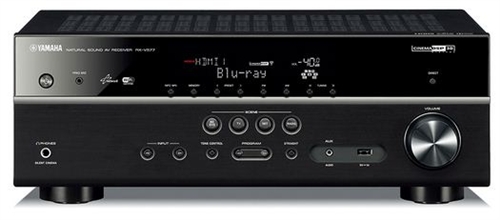
Click here to check out our facebook album with most of the steps photographed and explained.

This article was originally written for Yamaha’s now defunct RX-V577… The advice still holds true so I’ve updated it to suit their new models.
2015’s market-wide obsession with digital music formats all but renders ‘traditional’ hi-fi amplifiers obsolete. No longer just for CDs and records: to be really useful in 2015, a hi-fi system must connect phones, computers and iPods, NAS drives and digital or streamed radio and internet services to your speakers… And then it needs to have connections for your TV and disc player – and a turntable, if you use one.
It is possible, but we have to think outside the box. Stay with me… It’s taken some 2015 thinking to bundle all of today’s solutions into a convenient, easy-to-use package. And the heart of that package – and it’s an obscure suggestion to today’s analogue obsessed audiophile – is, in fact, a ‘surround sound’ or AV receiver! We’ll use an $1199 Yamaha RX-AS710 as an example.
Music is recorded in stereo so it makes sense that it should sound best played back in its native format. 2-speaker stereo! And, whilst not their intended use, AV receivers can sound extraordinary playing digital music in stereo. They have 1 major advantage over stereo designs and that is that they have built into them, a Digital-to-Analogue-Converter (or DAC). At the heart of an RX-AS710 is a 24bit/192kHz DAC – like you might find in a $500 CD player – that can be fed signals from any device with a digital output: HDMI, optical Toslink, coaxial SPDIF or USB, Ethernet or wi-fi. A digital signal has no ‘sound quality’ – it’s a computer file – and it’s not until data from that file enters a DAC that transforms into audio. Every digital source produces the same proficient – and surprisingly good – sound quality because it’s being generated by the same surprisingly good 24bit DAC. Of course, low bit-rate streams don’t sound quite as good as high bitrate streams – but, still, they all sound very good. That’s the number one reason we recommend an AV receiver. It’s why we categorize our AV receivers as ‘digital source components’.
And, for the audiophile on a budget, there are more advantages for stereo listening: 7.1 AV receivers take advantage of speakers’ bi-wire terminals and use 4 internal amplifiers to independently drive tweeters and woofers resulting in more dynamic, more present sound and higher volume capacity with lower distortion from your speakers. And, if your speakers or room aren’t acoustically perfect, a sophisticated microphone system calibrates the sound fed into your speakers to eliminate any unattractive sonic signatures or colourations. Yamaha calls it YPAO and the benefits are obvious. When you switch YPAO on, you can hear more even tone, more fine detail, each instrument is reproduced with mo0re of its own sonic character – and when you switch YPAO off with the ‘pure direct’ button, the sound is reduced to the capabilities of those speakers in that room. In our demo room, the sound is ‘thinner’ and the bass is uneven and boomy.
Besides amplifier technologies, the Yamaha RX-AS710 (and higher model AV receivers) have built-in wi-fi, an AM/FM radio, an internet radio, soundbar-style connectivity (to take advantage of Bravia, Viera or Anynet ‘link’ technologies), they also have a DLNA media player that browses and plays music from any computer on your network anywhere in your home, they connect directly to Spotify and Pandora music servers for improved sound quality, they have a USB connection so they work just like a dock but they source Apple audio as a digital signal to bypass the ordinary iPod electronics. They operate from an easy-to-use app on your phone or tablet, or with your regular or a TV remote – whichever is most convenient for the user at the time.
Maybe best of all, unlike a conventional analogue system – an RX-AS710 doesn’t require an expensive CD player to play CDs – HDMI out of any make of BluRay player sounds just fine played through a 24bit/192kHz DAC – so you might have more money to spend on an even better receiver (with an even better DAC) or better speakers.
Sub $2,000 ‘traditional stereo’ components simply can’t keep up when they’re compared side-by-side with an AV receiver…
Post $2,000? There are more choices available. But I’ll save that for another post.